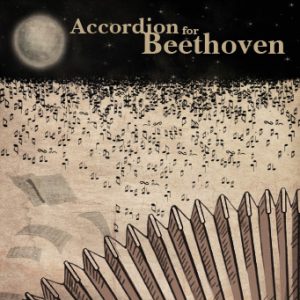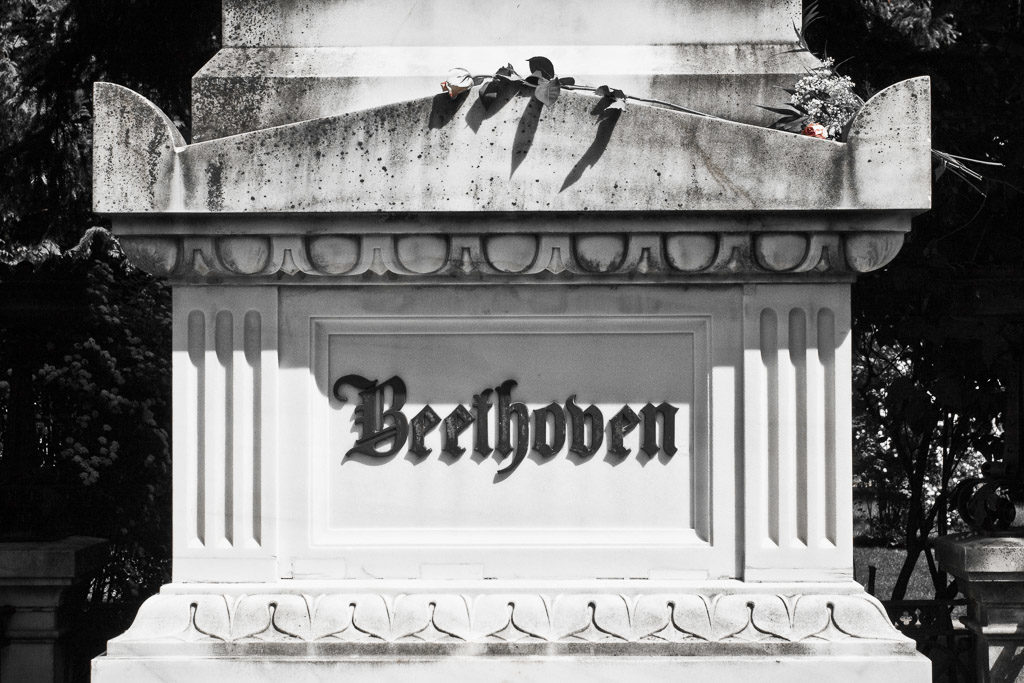“Accordion for Beethoven” – I Fünf Stücke für Flötenuhr nella trascrizione di Umberto Turchi (English version of this article)
 A pochi giorni dall’uscita del Compact Disc e dell’album digitale Accordion for Beethoven, Ars Spoletium pubblica la corrispondente collezione di trascrizioni, come ad offrire uno strumento nuovo e “differente” – la fisarmonica da concerto – alla creazione del grande compositore. Quella che sembra essere nota come la sua avversione nei confronti delle trascrizioni, risulta dalle fonti invece chiaramente rivolta a quegli interventi di trasposizione indiscriminata della scrittura pianistica, con particolare riferimento alle Sonate, da cui risulterebbero snaturate tanto l’identità strumentale quanto l’idea musicale. Invece, anche se raramente, Beethoven stesso trascrive, o meglio “trasforma” (per usare le sue parole) le sue opere per organici differenti: un esempio su tutti il Settimino op. 20, nato per violino, viola violoncello, contrabbasso, clarinetto, corno e fagotto, e trascritto per pianoforte, clarinetto (o violino) e violoncello, op. 38. Si tratta quindi di intendere la trascrizione non come operazione di “copiatura alla lettera” dell’opera originale, ma come una sorta di traduzione, trasformazione, riscrittura. La scrittura beethoveniana è per lo più altamente tipicizzata, connotante identità strumentali difficilmente inscindibili dall’idea musicale. Allo stesso tempo, è possibile che talvolta la scrittura pianistica celi, in sintesi, espressioni strumentali differenti. Ed è proprio qui che la fisarmonica interviene, cogliendo tali altre identità ed esprimendole riforgiando opportunamente la propria doppia natura di organo portativo espressivo e di ensemble polistrumentale in sintesi, con il suo suono polifonico, tenuto e variabile dinamicamente, estremamente duttile al gesto dell’esecutore. L’operazione di trascrizione di Accordion for Beethoven ha inizio, quindi, nella selezione del repertorio da trascrivere: una scelta, come si è già detto, non casuale, fondata sull’individuazione di una scrittura che suggerisse la traduzione di una presenza strumentale “altra” intrinseca nello strumento originale, ma sempre nel rispetto dell’integrità del contenuto musicale.
A pochi giorni dall’uscita del Compact Disc e dell’album digitale Accordion for Beethoven, Ars Spoletium pubblica la corrispondente collezione di trascrizioni, come ad offrire uno strumento nuovo e “differente” – la fisarmonica da concerto – alla creazione del grande compositore. Quella che sembra essere nota come la sua avversione nei confronti delle trascrizioni, risulta dalle fonti invece chiaramente rivolta a quegli interventi di trasposizione indiscriminata della scrittura pianistica, con particolare riferimento alle Sonate, da cui risulterebbero snaturate tanto l’identità strumentale quanto l’idea musicale. Invece, anche se raramente, Beethoven stesso trascrive, o meglio “trasforma” (per usare le sue parole) le sue opere per organici differenti: un esempio su tutti il Settimino op. 20, nato per violino, viola violoncello, contrabbasso, clarinetto, corno e fagotto, e trascritto per pianoforte, clarinetto (o violino) e violoncello, op. 38. Si tratta quindi di intendere la trascrizione non come operazione di “copiatura alla lettera” dell’opera originale, ma come una sorta di traduzione, trasformazione, riscrittura. La scrittura beethoveniana è per lo più altamente tipicizzata, connotante identità strumentali difficilmente inscindibili dall’idea musicale. Allo stesso tempo, è possibile che talvolta la scrittura pianistica celi, in sintesi, espressioni strumentali differenti. Ed è proprio qui che la fisarmonica interviene, cogliendo tali altre identità ed esprimendole riforgiando opportunamente la propria doppia natura di organo portativo espressivo e di ensemble polistrumentale in sintesi, con il suo suono polifonico, tenuto e variabile dinamicamente, estremamente duttile al gesto dell’esecutore. L’operazione di trascrizione di Accordion for Beethoven ha inizio, quindi, nella selezione del repertorio da trascrivere: una scelta, come si è già detto, non casuale, fondata sull’individuazione di una scrittura che suggerisse la traduzione di una presenza strumentale “altra” intrinseca nello strumento originale, ma sempre nel rispetto dell’integrità del contenuto musicale.
Così la collezione ha selezionato, accanto ad altre pagine beethoveniane che verranno prossimamente presentate sulle pagine di “Strumenti&Musica Magazine”, i Fünf Stücke für Flötenuhr WoO 33 (raramente pubblicati nella versione integrale) la cui scrittura, pur legittimamente traducibile nella dimensione organistica (e quindi fisarmonicistica), risulta vicina ad una idea di “musica pura” implicitamente permeata dalla presenza di un ensemble strumentale la cui immediatezza espressiva è resa tanto nella trascrizione quanto nell’esecuzione affidata alle due fisarmoniche di Patrizia Angeloni e di Umberto Turchi. La ricerca intorno ai cinque pezzi per organo meccanico ben chiarisce la natura dell’operazione. Dalle note introduttive a cura del trascrittore, Umberto Turchi, si legge:
“Queste cinque piccole opere vengono spesso divise in due gruppi: uno formato da tre lavori per flötenuhr (organo meccanico) intorno al 1799 (che comprende i brani III, IV e V di questa edizione) e un altro, formato da due brani senza indicazione di organico (che corrispondono ai primi due lavori di questa raccolta), scritti probabilmente intorno al 1795.  Non tutti gli studiosi sono concordi nell’accorpare questi brani, sebbene Kinsky (autore di uno dei più importanti cataloghi beethoveniani) abbia dimostrato oltre ogni ragionevole dubbio che anche l’Allegro non più molto (I) e l’Allegretto (II) siano stati concepiti per lo stesso organico (Kinsky 1927 in Albrecht 1981). Proprio Kinsky, nel suo catalogo, ha unito ai tre brani per organo meccanico anche questi due brani senza indicazioni strumentali, che in altri cataloghi vengono considerati come brani a sé stanti (Biamonti 200, Hess 106), a formare una vera e propria suite. Il Biamonti, pur separandoli dagli altri tre, li ha datati intorno al 1799, dunque grossomodo nello stesso periodo, mentre Hess aveva ipotizzato che appartenessero al periodo di Bonn. Attualmente, l’ipotesi più accreditata è che i due brani ‘contestati’ risalgano al 1794-95. Le fonti, in ogni caso, sono due manoscritti autografi conservati presso la Deutsche Staatsbibliothek di Berlino (Ms. mus. Grasnick e Ms. mus. Artaria).
Non tutti gli studiosi sono concordi nell’accorpare questi brani, sebbene Kinsky (autore di uno dei più importanti cataloghi beethoveniani) abbia dimostrato oltre ogni ragionevole dubbio che anche l’Allegro non più molto (I) e l’Allegretto (II) siano stati concepiti per lo stesso organico (Kinsky 1927 in Albrecht 1981). Proprio Kinsky, nel suo catalogo, ha unito ai tre brani per organo meccanico anche questi due brani senza indicazioni strumentali, che in altri cataloghi vengono considerati come brani a sé stanti (Biamonti 200, Hess 106), a formare una vera e propria suite. Il Biamonti, pur separandoli dagli altri tre, li ha datati intorno al 1799, dunque grossomodo nello stesso periodo, mentre Hess aveva ipotizzato che appartenessero al periodo di Bonn. Attualmente, l’ipotesi più accreditata è che i due brani ‘contestati’ risalgano al 1794-95. Le fonti, in ogni caso, sono due manoscritti autografi conservati presso la Deutsche Staatsbibliothek di Berlino (Ms. mus. Grasnick e Ms. mus. Artaria).
Le prime pubblicazioni dei Fünf Stücke sono parziali, e ad oggi sono rare le pubblicazioni complete di tutti e cinque i brani: la prima risale al 1902, ad opera dell’editore Steingräber, che però pubblicò solamente l’Adagio. L’editore Becking, nel 1921, curò l’edizione di un altro di questi brani, lo Scherzo. Il primo a pubblicare l’intera raccolta pare essere Schott, che nel 1940 ne pubblica una versione per pianoforte, curata da Georg Schuenemann. Molto critica in proposito l’opinione di Albrecht: ‘Sebbene presentati nella versione per pianoforte da Georg Schuenemann nel 1940, questi brani si adattano poco alla sonorità̀ del pianoforte. L’Allegro (n°5) e ancora di più l’Adagio Assai (n°3), hanno subito considerevoli alterazioni per poter risultare eseguibili al pianoforte, per non parlare della scarsa attendibilità della partitura di quell’edizione!’ (Albrecht 1981). L’edizione Peters del 1981 è la prima pubblicazione integrale di questi cinque brani, nella versione per organo che, secondo Albrecht, sarebbe lo strumento più vicino alla sonorità originale del flötenuhr.
La trascrizione dei Fünf Stücke (in particolare dell’Adagio Assai) per vari organici è un processo invalso ormai da diverso tempo. Per citare solo alcuni esempi, si vedano le seguenti trascrizioni: per violoncello e pianoforte (trasposta in re maggiore) curata da J. Van Lier e pubblicata da Steingräber nel 1902; per pianoforte solo curata da V. P. Vretblad pubblicata sulla rivista ‘Damemas Musikblad’ di Stoccolma nel 1902 (poi ripubblicata tra il 1906 e il 1910 sulle pagine dell’‘Orgel und Pianomagasin’ di Nahlstrom); per flauto, oboe, clarinetto, fagotto e corno realizzata dal Kappelmeister Böhme nel 1902 (tuttora inedita); per flauto, due oboi, due clarinetti, due fagotti e due corni, a cura di Willy Hess pubblicata dalla Breitkopf&Hartel nel 1957. La fisarmonica da concerto, che si configura come un vero e proprio discendente moderno dell’organo portativo (e dunque, in senso lato, dell’organo meccanico), si presta in maniera particolare a raccogliere l’eredità musicale dello strumento originale, non solo per la vicinanza organologica, ma anche per le originali possibilità di sintesi di molteplici modalità espressive difficilmente individuabili in altri strumenti.
La trascrizione per fisarmonica da concerto di repertori del periodo classico è molto spesso legata all’organo meccanico (si veda a questo proposito la Fantasia K608 di W.A. Mozart), il che contribuisce a sostenere la legittimità della trascrizione per fisarmonica di questi cinque brani. Per questa trascrizione si è scelto il principio della massima aderenza alle fonti originali, siano esse di tipo catalografico che di tipo più strettamente musicale”.
Accordion for Beethoven: cd e album digitale
https://www.arspoletium.com/catalogo/cd-music/classica/accordion-for-beethoven/
https://backl.ink/143508944
Umberto Turchi
https://www.arspoletium.com/artists/umberto-turchi/
————————————————————————————
“Accordion for Beethoven” – Fünf Stücke für Flötenuhr in Umberto Turchi’ transcription
 A few days after the release of the compact disc and digital album Accordion for Beethoven, Ars Spoletium publishes the corresponding collection of transcriptions, as to offer a new and “different” instrument – the accordion concert – to the creation of the great composer. What seems to be known as his aversion to transcriptions, instead clearly results from the sources turned to those interventions of indiscriminate transposition of piano writing, with particular reference to the Sonatas, which would distort both the instrumental identity and the musical idea. Instead, although rarely, Beethoven himself transcribes, or rather “turn” (to use his words) his works for different organics: an example of all the Septet op. 20, born for violin, viola violoncello, double bass, clarinet, horn and bassoon, and transcribed for piano, clarinet (or violin) and cello, op. 38.
A few days after the release of the compact disc and digital album Accordion for Beethoven, Ars Spoletium publishes the corresponding collection of transcriptions, as to offer a new and “different” instrument – the accordion concert – to the creation of the great composer. What seems to be known as his aversion to transcriptions, instead clearly results from the sources turned to those interventions of indiscriminate transposition of piano writing, with particular reference to the Sonatas, which would distort both the instrumental identity and the musical idea. Instead, although rarely, Beethoven himself transcribes, or rather “turn” (to use his words) his works for different organics: an example of all the Septet op. 20, born for violin, viola violoncello, double bass, clarinet, horn and bassoon, and transcribed for piano, clarinet (or violin) and cello, op. 38.
It is therefore a matter of understanding the transcription not as an operation of “copying” the original work, but as a sort of translation, transformation, rewriting. Beethoven’s writing is mostly highly typified, connoting instrumental identities hardly inseparable from the musical idea. At the same time it is possible that sometimes piano writing conceals, in summary, different instrumental expressions. And it is precisely here that the accordion intervenes, capturing these other identities and expressing them by appropriately forging its dual nature of expressive carrier organ and poly-romanian ensemble in synthesis, with its polyphonic sound, continous and dynamically variable, extremely ductile to the gesture of the performer. The work of transcription by Accordion for Beethoven begins then in the selection of the repertoire to be transcribed: a choice, as has already been said, not accidental, based on the identification of a writing that suggested the translation of an instrumental presence “other” intrinsic to the original instrument, but always respecting the integrity of the musical content.
So the collection has selected, alongside other Beethoven pages that will be presented soon on the pages of in Strumenti&Musica Magazine, the Fünf Stücke für Flötenuhr Woo 33 (rarely published in full version) whose writing, although legitimately translatable into the organ dimension (and therefore accordion), is close to an idea of “pure music” implicitly permeated by the presence of an instrumental ensemble whose expressive immediacy is rendered both in the transcription and in the performance entrusted to the two accordions of Patrizia Angeloni and Umberto Turchi. The search around the five pieces for mechanical organ well clarifies the nature of the operation. From the introductory notes by the transcriber, Umberto Turchi, we read: «These five small works are usually divided into two groups: one consisting in three works for flötenuhr (mechanical organ) written around 1799 (which includes pieces III, IV and V of this edition), and another one consisting in two works without indication of organic (which correspond to the first two works of this collection), probabily written around 1795.  Not all scholars are in agreement in merging these pieces, altough Kinsky (author of one of Beethoven’s most important catalogues) has shown beyond any reasonable doubt that the Allegro non più molto (I) and the Allegretto (II) were also conceived for the same ensemble (Kinsky 1927 in Albrecht 1981) Kinsky himself, in his catalogue, has combined the three pieces for mechanical organ with these two pieces without instrumental indications, which in other catalogues are considered as separate pieces (Biamonti 200, Hess 106), to form a real suite. The Biamonti, although separating them from the other three, dated them around 1799, therefore roughly the same period, while Hess had assumed that they belonged to the Bonn period. Currently the most reliable hypothesis is that the two “contested” pieces date back to 1794-95. The sources, in any case, are two autograph manuscripts preserved at the Deutsche Staatsbibliothek in Berlin (Ms. mus. Grasnick and Ms. mus. Artaria).
Not all scholars are in agreement in merging these pieces, altough Kinsky (author of one of Beethoven’s most important catalogues) has shown beyond any reasonable doubt that the Allegro non più molto (I) and the Allegretto (II) were also conceived for the same ensemble (Kinsky 1927 in Albrecht 1981) Kinsky himself, in his catalogue, has combined the three pieces for mechanical organ with these two pieces without instrumental indications, which in other catalogues are considered as separate pieces (Biamonti 200, Hess 106), to form a real suite. The Biamonti, although separating them from the other three, dated them around 1799, therefore roughly the same period, while Hess had assumed that they belonged to the Bonn period. Currently the most reliable hypothesis is that the two “contested” pieces date back to 1794-95. The sources, in any case, are two autograph manuscripts preserved at the Deutsche Staatsbibliothek in Berlin (Ms. mus. Grasnick and Ms. mus. Artaria).
The first publications of the Fünf Stücke are partial, and today there are few complete publications of all five pieces: the first one dates back to 1902, by the publisher Steingräber, who only published the Adagio. The publisher Becking, in 1921, edited another of these pieces, the Scherzo. The first to publish the entire collection seems to be Schott, who in 1940 published a version for piano, edited by Georg Schuenemann. Albrecht’s opinion on the subject is very critical: “Although presented in the piano version by Georg Schuenemann in1940, these pieces are hardly adapted to the sound of the piano. The Allegro (n°5) and even more the Adagio Assai (n°3), have undergone considerable alterations in order to be performed on the piano, not to mention the poor reliability of the score of that edition!” (Albrecht1981).
The 1981 Peters edition is the first complete publication of these five pieces, in the organ version which, according to Albrecht, would be the closest instrument to the original flötenuhr sound. The transcription of the Fünf Stücke (inparticular of the Adagio Assai) for various staff is a process that has been established for some time now. To cite just a few examples, see the following transcriptions: for cello and piano (transposed in D major) edited by J. Van Lier and published by Steingräber in 1902; for piano solo edited by V. P. Vretblad published in the magazine Damemas Musikblad in Stockholm in 1902 (later republished between 1906 and 1910 on the pages of Nahlstrom’s Orgel und Pianomagasin); for flute, oboe, clarinet, bassoon and horn by Kappelmeister Böhme in 1902 (still unpublished); for flute, two oboes, two clarinets, two bassoons and two horns, edited by Willy Hess published by Breitkopf&Hartel in1957.
The concert accordion, which is configured as a true modern descendant of the portative organ (and therefore, in a broad sense, of the mechanical organ), lends itself in a particular way to collect the musical heritage of the original instrument, not only for the organological proximity, but also for the original possibilities of synthesis of multiple modes of expression difficult to identify in other instruments. It should also be noted that the transcription works are an integral part of the accordion repertoire, in which the instrument is the protagonist of different rewritings starting from ancient music. The concert accordion transcription of repertoires from the classical periodis very often linked to the mechanical organ (see W. A. Mozart’s Fantasia K608), which helps to support the legitimacy of the accordion transcription of these five pieces.
For this transcription we have chosen the principle of maximum adherence to the original sources, whether catalographic or more strictly musical, and therefore not to add any kind of performance indication with respect to the manuscript, instead often present in the various editions».
Accordion for Beethoven: cd and digital collection
https://www.arspoletium.com/catalogo/cd-music/classica/accordion-for-beethoven/
https://backl.ink/143508944
Umberto Turchi
https://www.arspoletium.com/artists/umberto-turchi/

